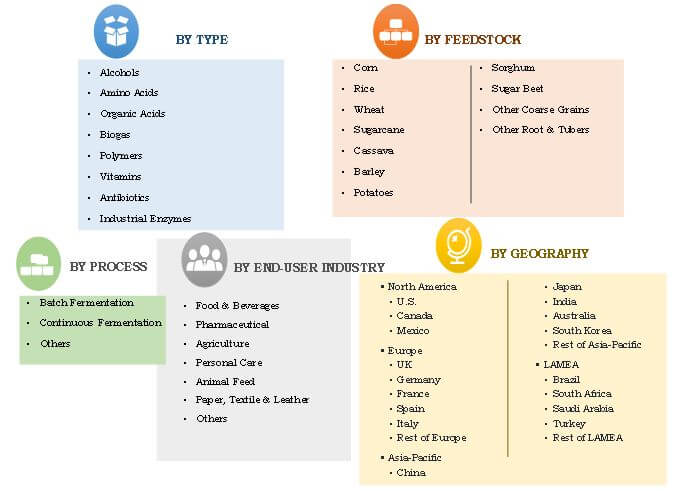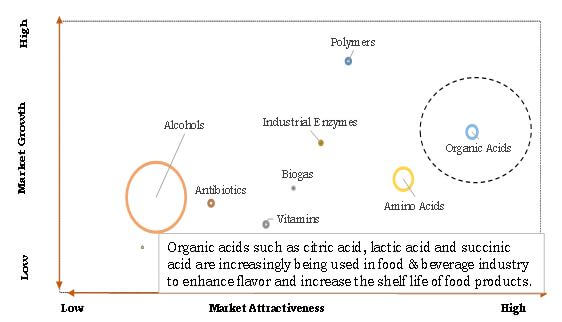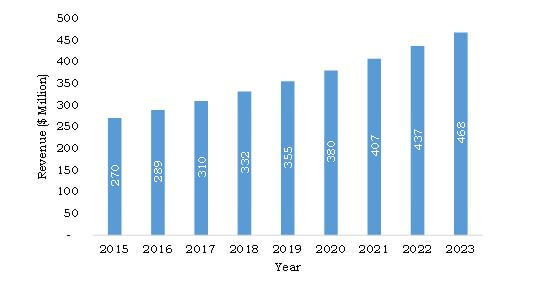Fermentation Products Market Overview:
The Fermentation Products Market was valued at $149,469 million in 2016, and is expected to reach $205,465 million by 2023, registering a CAGR of 4.7% from 2017 to 2023. Fermentation is a metabolic process that involves conversion of sugar, cellulosic material, and starch into food, feed, fuel, and other industrial products. This conversion uses microorganisms or enzymes as raw materials and is carried out in bioreactors or fermenters. After this process, subsequent downstream processing is required to purify and isolate the target product. Fermentation products are necessary ingredients utilized in the production of bio-based products. Stringent government regulations imposed by key regulatory authorities in developed economies are anticipated to increase the demand for fermentation products during forecast period. These products assists in food preservation and extend shelf life of products in the food & beverage industry. Continuous R&D activities and acquisitions & mergers have been adopted by fermentation product manufacturers to expand their existing product portfolio and increase their market share.
Growth of the bioethanol industry, and rise in awareness among customers regarding bio-based products and ecological concerns drive growth and development of fermentation products market. Increase in demand for antibiotics & steroids and rise in use of fermentation products as raw material in textile, leather, plastic, chemical, and rubber industries further supplement market growth. Antibiotics are chemical substances, which possess the ability to kill or inhibit growth of microorganisms, and therefore are utilized to fight infections in animals or humans. Surge in incidence of diseases such as diarrhoea, bronchitis, sore throat, cold & flu, and ear pain & sinus infections among population and increase in prevalence of soft tissue & skin infections are the primary factors driving the demand of antibiotics across the globe. The current demand–supply gap and substantial investments in R&D activities by various biotech companies are expected to further boost the demand. Antibiotics are derived from microorganisms, and are manufactured at industrial scale using fermentation process, either for direct use in human therapy or to act as feedstock for synthesis of chemically modified derivatives. Penicillin’s, cephalosporins, fluroquinolones, tetracyclines, and macrolides are some of the examples of antibiotics available in the market. Thus, increase in use of antibiotics is expected to increase the demand for fermentation products across the globe, thereby driving the market growth. North America is the leading region, due to increase in popularity of food and pharmaceutical products produced by use of fermentation products. Regulations framed by agencies, such as the Environmental Protection Agency (EPA) and European Commission, categorically promote green chemistry, growth of which is supported by utilization of fermentation products. However, irregular supply of raw materials, such as nutrients & microorganisms utilized in production of fermentation products, stringent regulations, and high manufacturing cost limit the market growth. In addition, economic viability of global fermentation-based chemical industry depends on price of alternative feedstock and relative product yields. Diversified demand for fermentation products in the emerging economies, such as India, China, and Brazil, technological innovation, and rise in number of applications are anticipated to provide lucrative opportunities for market expansion.
However, irregular supply of raw materials and high production cost of fermentation products limits the market growth. Raw materials utilized in production of fermentation products include microorganisms, fermentable sugars, and nutrients. Saccharomyces cerevisiae, Corynebacterium glutamicum, and Lactobacillus bulgaricus are some of the microorganisms utilized in the manufacturing of alcohols, amino acids, and organic acids, respectively. Moreover, industrial enzymes production utilizes large amount of yeast and bacteria. In addition, fermentation procedures utilize some of the vitamins as raw materials such as vitamin C, vitamin K, and vitamin B group. Supply of these microorganisms, fermentable sugars, and vitamins is irregular, which limits the market growth.
On the contrary, diversified demand for fermentation products in the emerging economies, such as India, China, and Brazil, technological innovation, and rise in number of applications are anticipated to provide lucrative opportunities for market expansion. In addition, technological innovation in the fermentation products manufacturing is expected to offer lucrative growth opportunities. Fermentation technology is a favoured biological process due to its high specificity, simplicity of reaction, and versatility of application. Modern industries have complemented basic fermentation principle with advanced techniques to extend application range of fermentation and its products. A wide variety of biomolecules, biochemical, and biofuels are produced as a result of fermentation. Organic acids processed through industrial fermentation techniques have high adoption in oil & gas well treatment procedures in petroleum industry. In addition, nutritional & preserved foods involve consumption of organic acids, further fueling the market growth. Amino acids are now being utilized in infusion solutions and have become an essential part of modern medical treatments. Fermentation products are also being utilized as significant raw materials in pet food manufacturing; thus, surge in the demand for animal feed additives across the globe is anticipated to further boost the market growth.
The fermentation products market is segmented based on type, feedstock, process, end-user industry, and geography. On the basis of type, it is divided into alcohols, amino acids, organic acids, biogas, polymers, vitamins, antibiotics, and industrial enzymes. According to feedstock, it is categorized into corn, rice, wheat, sugar cane, cassava, barley, potatoes, sorghum, sugar beet, other coarse grains, and other roots & tubers. Other coarse grains comprise oats, millet, triticale, buckwheat, rye, canary seed, fonio, and quinoa, while other roots & tubers include yams, sweet potatoes, yautia, and taro. Based on process, the market is classified into batch fermentation, continuous fermentation, and others (aerobic fermentation and anaerobic fermentation). According to end-user industry, it is divided into food & beverages; pharmaceutical; agriculture; personal care; animal feed; textile & leather; and others (paper, bioremediation, environment, and biochemistry). Geographically, the market is analyzed across North America, Europe, Asia-Pacific, and LAMEA.
Top Investment Pocket
Organic acids segment is the most prominent segment by type in global fermentation products market, and is expected to be first preference for new entrants, due to their high use in food & beverage industry. Lactic acid is utilized in food & beverage products as a flavor enhancer, acidulant, and shelf life extender.
Asia-Pacific Analysis
India accounted for the highest market share in the Asia-Pacific fermentation products market in 2016, owing to high demand for antibiotics. Progress in the bioethanol industry and rise in awareness among consumers about the benefits associated with bio-based products propel the demand of fermentation products in the region. South Korea fermentation products market generated revenue of $289 million in 2016, and is estimated to reach $468 million by 2023, growing at a CAGR of 7.1% during the forecast period.
South Korea Fermentation Products Market, 2015-2023 ($Million)
Key leading players operating in this market include AB Enzymes GmbH, Ajinomoto Company Incorporation, Amano Enzyme Inc., BASF SE, Chr. Hansen A/S, Du Pont Danisco A/S, Evonik Industries AG, Lonza Group Ltd., Novozymes A/S, and The Dow Chemical Company.
The other key market players in the value chain include Koninklijke DSM N.V., Archer Daniels Midland Company, Cargill Inc., Alcogroup S.A., Syngar Technologies Inc., Dhler Group, CBH Qingdao Co., Ltd., and Hebei Kangdali Pharmaceutical Co., Ltd.
Key Benefits for Stakeholders
- This report provides quantitative & qualitative analyses of the current market trends and estimations from 2016 to 2023, which assists to identify the prevailing market opportunities.
- Market trends of major countries in each region are mapped according to anticipated market revenue.
- Top investment pockets highlight the opportunities in the most lucrative application segment.
- Comprehensive analysis of the factors that drive and restrict the growth of fermentation products market is provided.
- An in-depth analysis of different regulations within the market is provided.
- Key manufactures of fermentation products are profiled and their recent developments are listed.
Fermentation Products Market Report Highlights
| Aspects | Details |
| By End-use Industry |
|
| By Process |
|
| By Feedstock |
|
| By Type |
|
| By Region |
|
| By Key Market Players |
|
Analyst Review
Imposition of stringent environment regulations by various regulatory authorities, such as Environmental Protection Agency in developed regions, is anticipated to increase the fermentation products demand by many folds in the near future. Growth of the bioethanol industry, ecological concerns, and increase in demand for fermented alcohols & antibiotics drive the fermentation products market globally. Increase in awareness among consumers about benefits of bio-based products and rise in application areas in industrial biotechnology further contribute to market growth. Fermentation products are utilized in food & beverage industry to increase shelf life of the products and add a texture, flavor, or aroma to them.
Organic acids processed through industrial fermentation techniques have high adoption in oil & gas well treatment procedures in petroleum industry. In addition, nutritional & preserved foods involve consumption of organic acids, further fueling the market. Fermentation products are utilized as significant raw materials in pet food manufacturing; thus, growth in demand for animal feed additives across the globe is anticipated to further boost the market growth. Prominent market players have made high investments in R&D activities to enhance their technological base, diversify their product offerings, and increase their geographical outreach.
Economic growth and rise in disposable income have fueled the market growth in emerging economies, such as India and China. Special schemes and policies by government to boost manufacturing of bio-based products play a significant role in growth and development of fermentation products market in emerging countries, especially India. Increase in popularity of pharmaceutical and food products, which are manufactured using fermentation products, is expected to propel demand for fermentation products in North America.
Loading Table Of Content...





